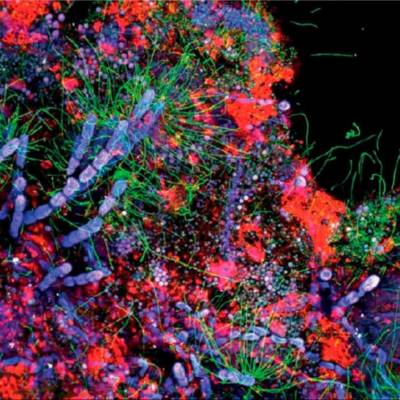The term EPS first appeared in 1982, when the substances of biological origin responsible for the formation of microbial aggregates were referred to. EPS was defined as an extremely hydrated gel ( 98% water) consisting of a network of fibres from a consortium of microbial species encapsulated in it, which can include both prokaryotic and eukaryotic cells. For years, the term EPS associated with biofilms stood for exopolysaccharides. EPS have slowly gained the attention of more researchers, recognising the fundamental role of the matrix. A famous 1999 publication by Wingender et al. ‘Microbial Extracellular Polymer Substances’ also emphasised for the first time the role of proteins as an important, constituent and significant part of EPS. The term was expanded from ‘exopolysaccharides’ to the more general form of ‘extracellular polymeric substances’, which included proteins, nucleic acids and lipids, as opposed to ‘exopolysaccharides’, which would only cover one component of the matrix. All these polymers together form the complex matrix in which extensive microbial communities live, which can be found in the form of mobile aggregates and/or stationary films. Opening the window to the further relevance of EPS, the authors stated that to increase complexity, not only are a variety of different extracellular polymers present in the matrix, but it is likely that many of these polymers interact with each other depending on their chemical composition, nature and positioning.
EPS structure
As early as 1978, it was stated in a publication by Geesey et al. that biofilms are not simply an accumulation of bacteria but are well structured and organised. It was by Thomas Neu and John Lawrence, using laser scanning confocal microscopy (CLSM), that the first fantastic images of this complexity were generated, clearly revealing that the EPS matrix is highly structured with distinct components and zones, and not just an amorphous gel.

Another milestone in the exploration of the structure of the EPS matrix was the introduction of microelectrodes within the matrix itself. This made it possible to study, for example, the different oxygen distribution within it and the pH gradients. It was precisely the study of oxygen distribution that made it possible, for example, to understand how it was possible for aerobic and anaerobic microorganisms to coexist within the same matrix. This coexistence, which might seem ‘against nature’, is actually possible due to the fact that aerobic micro-organisms, quickly consuming oxygen before it can diffuse into the deeper layers of the matrix, contribute to the formation of anaerobic pockets where anaerobic micro-organisms can live.
Functions of the EPS
The road from EPS as an amorphous matrix to that of a functional, differentiated structure, as shown in the figure below, has been a long one. This view has changed dramatically over the years. Indeed, the matrix provides the stage for the emergence of the extraordinary properties of biofilms.

These properties are observed during the process of biofilm self-organisation in complex systems. Here, the properties of the microorganisms within the community are different from those observed on the organisms themselves taken individually. One consequence is the formation of the biofilm habitat, characterised by strong gradients, high biodiversity and complex, dynamic and synergetic interactions including increased horizontal gene transfer and true multicellularity characteristics. The agglomerated components in the matrix are not just a cluster of macromolecules but perform many important functions in the life of the biofilm cells. The cohesion and mechanical stability of the EPS components are provided by weak physicochemical interactions and bonds between proteins and polysaccharides, nucleic acids as well as curli, fimbriae, cellulose and amyloid substances. The role of individual EPS components can be very important. The table below shows some known functions performed by the different components of EPS.
| FUNCTION OF EPS | ACTION ON THE MICROBIAL COMMUNITY | EPS COMPONENTS INVOLVED |
| ADHESION | Colonisation of biotic to abiotic surfaces by plactonic cells | Polysaccharides, proteins, eDNA |
| AGGREGATION | Recognition between different micro-organisms, formation of zones of high microbial density | Polysaccharides, proteins, DNA |
| COHESION | Creation of a hydrated polymer network using functional elements, determination of the EPS architecture | Polysaccharides, proteins, DNA |
| WATER RETENTION | Maintaining highly hydrated areas, promoting resilience even in very dry environments | Hydrophilic polysaccharides and proteins; hydrophobic proteins to form a protective layer limiting water loss |
| PROTECTIVE BARRIER AGAINST ANTIMICROBIAL AGENTS | Specific and non-specific resistance to other micro-organisms and/or cells, tolerance to various antimicrobial agents and disinfectants | Polysaccharides and proteins |
| ABSORPTION OF POLAR COMPOUNDS AND INORGANIC IONS | Accumulation of nutrients from the external environment and ions to promote the formation of a resistant polymer network | Polysaccharides and proteins |
| ABSORPTION OF PARTICLES AND APOLAR COMPOUNDS | Accumulation of resources from the environment outside the matrix | Polysaccharides and proteins, adhesive components of the matrix |
| INCREASED ABSORPTION CAPACITY | Through specific enzymatic activities or vesicle formation, the absorption of useful substances is stimulated | Enzymes, proteins, membrane vesicles |
| ENZYME ACTIVITIES | Digestion of external molecules to promote migration, degradation of matrix areas to promote cell release | Protein |
| SOURCE OF NUTRIENTS | The matrix is the same source of carbon, phosphorus and nitrogen for the communities present | All EPS components |
| EXCHANGE OF KIND INFORMATION | Horizontal gene transfer between cells within the microbial community | DNA |
| INTRACELLULAR INFORMATION | Regulation of biofilm dynamics by Quorum sensing | Polysaccharides |
| BINDING WITH ENZYMES | Accumulation, retention and stabilisation of enzymes through interaction with polysaccharides | Polysaccharides, enzymes |
In the second part of the publication, we will address other important characteristics of the polymer matrix, and the role our patented BIOREM® enzyme can play in its removal.



